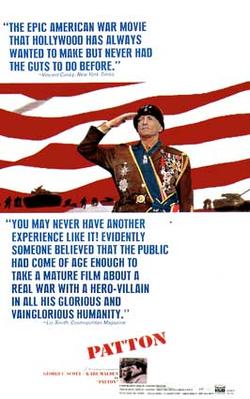I recently
watched “Patton” on the big screen for the first time since It was released in
1970. To make the viewing even more memorable
I read Making Patton by Nicholas Evan Sarantakes. It is a fascinating look at everything involving
the film. Needless to say, it was not an
easy film tp make. As I read, I jotted
down interesting facts to share with my readers. Enjoy!
1. George C. Scott did not
want the speech at the start of the movie because he felt it would be hard to
top.
2. Producer Frank McCarthy
graduated from VMI and eventually rose to be George Marshall’s chief aide. He met Patton several times. He planned FDR’s funeral. The was Assistant Secretary of State under
Truman. He suffered several nervous
breakdowns due to overwork. He went to
work for Hollywood mogul Darryl Zanuck.
He was co-producer on “Decision Before Dawn”.
3. Columbia Pictures wanted
to make the movie in 1950, but Beatrice Patton nixed the deal because the
family hated the media for its role in Patton’s controversies. She died in 1953, but the children shared her
opposition to any film about their father.
In 1961, McCarthy got himself assigned as assistant to the chief of
information, US Army and got the Army to approve the project for 20th
Century Fox with requiring family approval.
The family hired a lawyer to try to derail the project, which didn’t
happen, but did result in a better script.
The family ended up liking the finished film.
4. McCarthy’s first choice
was Burt Lancaster. The studio wanted
John Wayne. Zanuck suggested Scott.
5. The near bankruptcy of
20th Century due to “Cleopatra” set the project back several years.
6. When Ladislas Farago’s
book Ordeal and Triumph, 20th Century bought the rights and
Zanuck took up the project and assigned David Brown to produce. McCarthy was
brought on board. Calder
Willingham wrote a treatment that was not wedded to accuracy. McCarthy was disappointed and hired Francis
Ford Coppola. McCarthy watched over his
shoulder and they collaborated. Ed North
revised the script. He did not
collaborate with Coppola. He added
historical accuracy and cut a scene involving Patton’s disastrous attempt to
rescue his son-in-law from a German prison because he rightfully felt it
cancelled the vibe from the Bastogne segment.
7. Director Franklin Schaffner
was coming off “Planet of the Apes”. He
insisted the studio remove the subtitle “Blood and Guts”.
8. Shooting began in Spain
17 years, 3 months, and 11 days after McCarthy had first proposed the project.
9. 72 locations were used.
10. A total of eight days
were lost to Scott’s drinking. It did
not help that James Edwards (Meeks) was an alcoholic who instigated and
facilitated Scott’s binges. McCarthy
filmed Edwards’ scenes early and then fired him. He gave some of Edwards’ lines to others like
Paul Stevens (Codham). Karl Malden took
on the task of dining with Scott and keeping liquor away. Because of what he saw of the effects of
alcohol on Scott, Malden gave up drinking.
11. Jerry Goldsmith’s score
is iconic, but there is only 30 minutes of music in the movie.
12. Richard Nixon
legendarily saw the movie dozens of times, but official White House records
only confirm three.
13. Schaffner and North
claimed that the movie was anti-war (i.e., it takes a personality like Patton
to win wars), but McCarthy insisted it was pro-Army.
14. It was entitled
“Patton: Lust for Glory” in Great
Britain where it got good reviews in spite of the portrayal of Montgomery.
15. It seems likely that
the two mules were actually euthanized before they were dumped over the bridge.
Here is the speech

No comments:
Post a Comment
Please fell free to comment. I would love to hear what you think and will respond.